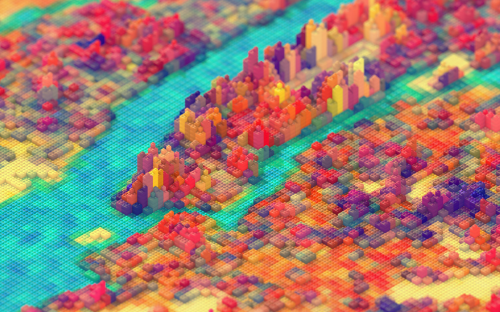Models of maps have always provided us with tangible objects that allow us to see the world. Think globes, plaster models, heat-moulded plastic relief models etc. And now to that list add Lego. The ultimate children’s toy used to create a fantastic model of New York.
Lego, of course, has been used to create all manner of objects and its basic square form acts as a perfect analogy to a rasterised pixel. A great deal of digital data and satellite imagery is in raster format so makes a natural basis to recreate in physical form. This is precisely what Schmidt has done here, taking a range of pixelated maps and satellite images that illustrate land use and elevation and using them to codify his Lego landscape. The blocks are unnaturally colourful but somehow create a quilted pattern that replicates the areas of human use and associated densities. The colours act as a metaphor for the complexity of New York. Height of the blocks gives us a skyline with the New York skyscrapers easily imagined. The surrounding boroughs display more subtle elevation changes. COlours become a little muted nearer the water which itself is a pleasing textured collection of blues rather than a single colour.
Models are a great way of exploring spaces and provide hours of enjoyment. What can be better than Lego and maps?!
More details at Schmidt’s web site here.
Possibly not worthy of a separate MapCarte but others have also experimented with Lego to create geographical models. Here’s a few:
Harry Beck Lego tube maps here.
London bus shelter on Regent’s Street here.
United States of Lego web map here.
Where are all the lego bricks? (3D web map) here.


